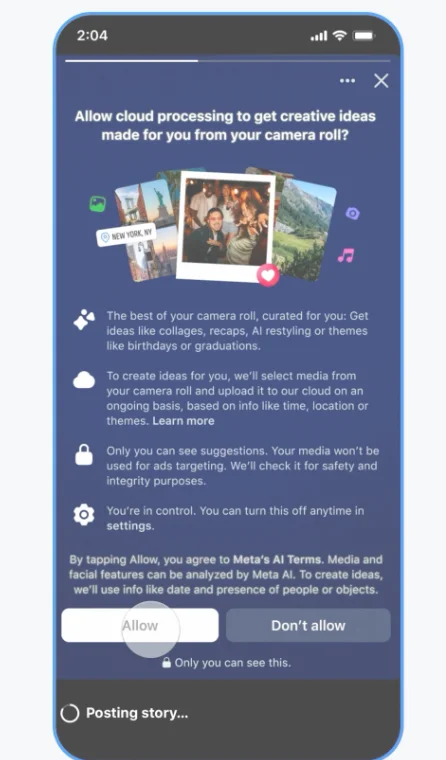Facebook’s newest AI feature wants a sneak peek at your camera roll — even the photos you’ve never posted. And while the company says it won’t train its models on that media unless you share or edit it, that fine print may leave you wondering what you’re really opting into.
Key Takeaways
- Meta’s new Facebook tool scans unpublished photos in your phone’s camera roll.
- The feature is opt-in and currently rolling out in the U.S. and Canada.
- Uploaded media purportedly won’t train Meta’s AI unless you edit or share it.
- Meta says the data won’t fuel ad-targeting, but concerns remain.
- Your “hidden gems” become fodder for creative collages — and deeper data access.
Facebook’s new opt-in feature gives Meta’s AI access to your phone’s camera roll — uploading unpublished photos to its cloud so it can suggest edits and collages. Meta says it won’t use that media to train its AI unless you edit or share the suggested content.
What’s happening
Meta has launched a new feature within Facebook that, when opted into, allows its AI to continuously upload photos and videos from your phone’s camera roll to Meta’s cloud in order to automatically surface “hidden gems” and create suggested edits, collages and highlight reels.
The rollout is currently limited to U.S. and Canadian users, with other regions to follow.
According to Meta: “We don’t use media from your camera roll to improve AI at Meta, unless you choose to edit this media with our AI tools, or share.”
How it works in your phone
- You enable the feature (opt-in).
- Facebook asks permission to allow “cloud processing… to get creative ideas made for you from your camera roll.”
- Your phone’s camera roll begins uploading media to Meta’s cloud infrastructure so that AI can analyse the files, pick out standout moments (e.g., holiday snaps, candid smiles, pet pics) and generate suggestions.
- You view suggested edits/collages. You then choose whether to save them, share them in Feed or Stories, or ignore them.
- Only after you engage with an edit (by editing or sharing it) does Meta say the media may be used to “improve AI at Meta.”

Why it matters
For people who use Facebook casually, this feature promises effortless “make-your-photos-look-better” utility. But the deeper implication is that Meta now gets access to photos you haven’t posted, stored in your camera roll — files you likely keep private.
The fact that such media can be uploaded and processed before you make any decision adds a layer of risk. Even if Meta claims these files won’t train its AI unless you share or edit, the storage and processing nonetheless expose your personal snapshots to a big tech company’s servers.
Given the company’s prior record — it previously trained its AI on all public Facebook and Instagram images/posts since 2007 — the caveats matter.
For EU users especially, where regulations such as the General Data Protection Regulation (GDPR) restrict personal-data use, the rollout raises questions about how safe such access really is.
The bigger picture: Data & Trust
Meta is positioning this as a fun and helpful tool — surfacing memories, making sharing easier. But in the era of heightened scrutiny of big-tech data practices, the move looks like another bait-and-switch.
- Uploading unpublished photos means Meta gets richer insight into your personal life — your location metadata, facial info, companions, objects, patterns.
- The “we won’t train AI unless you share/edit” line feels dependent on future changes. Past behaviour suggests policy can shift.
- For regulators, this raises privacy and transparency concerns — especially in regions like the EU, where user consent and data minimisation are stricter.
What users should watch
- Consent clarity: When you see the opt-in prompt, check exactly what you’re agreeing to — uploading, cloud processing, where files are stored, how long, etc.
- Toggle settings: Facebook will offer a “Camera roll sharing suggestions” toggle and a separate “cloud processing” toggle. You can disable both.
- Retention period: Meta acknowledged that during tests it “might keep some data for longer than 30 days,” though it hasn’t clarified this in its public blog for final rollout.
- Use-cases: If you never intended to share many photos, this feature may feel intrusive rather than helpful.
- Geographic rollout & regulation: U.S./Canada only (for now). In the EU, regulators may require additional safeguards.
Global & regulatory implications
In markets such as India, the U.K. or EU nations, privacy regulators are already probing how AI systems use personal photos — especially those not explicitly shared.
Meta’s rollout could therefore trigger regulatory pushback or forced modifications. For example, its decision not to release its advanced multimodal model in the EU was tied to regulatory unpredictability.
There’s also reputational risk: If users feel their unpublished, private photos are being “mined” for data under the guise of optional sharing, trust erodes — and with it, engagement.
What happens next
- Meta will gradually expand the feature beyond the U.S./Canada in “the coming months”.
- Expect privacy advocacy and regulators in the EU and elsewhere to scrutinise how this kind of “camera-roll access” is managed.
- For users: keep an eye on your Facebook app’s settings, toggle off “camera roll sharing suggestions” if you’re uncomfortable, and consider limiting what’s stored in your device’s general camera roll.
Conclusion
Meta’s new Facebook feature offers a neat trick — algorithmically surfacing forgotten photos and helping you share them with flair. But behind the veneer of convenience is a significant change in data access: unpublished photos sitting on your phone are now potentially available — for upload and analysis — simply by opting in. If you value privacy as much as memories, the decision to enable or skip this feature deserves real scrutiny.
